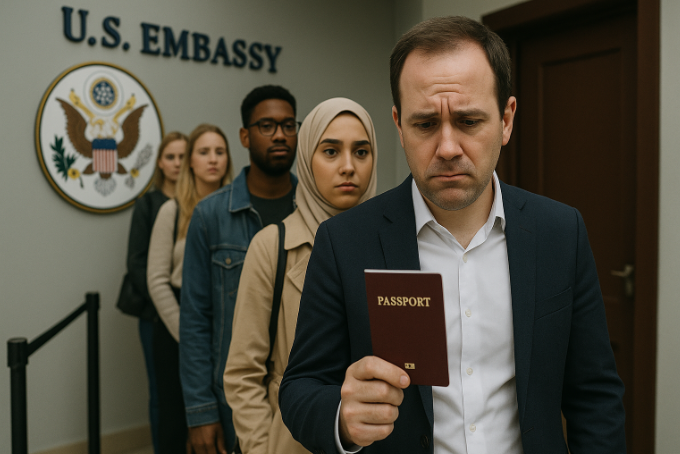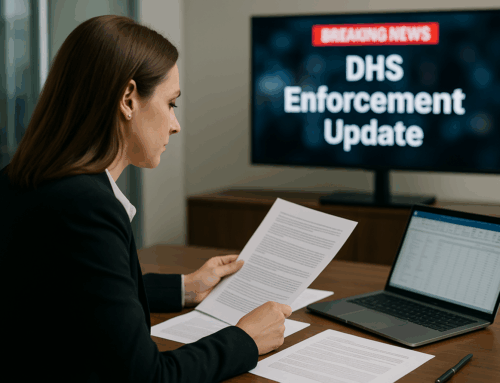It happens more often than you think. An HR leader spends months securing an approved petition for a critical employee. The trip home for visa stamping seems routine—until the consular officer says “denied” in under two minutes. No papers reviewed. No second chance.
This is the reality of high-volume consular interviews where decisions are made under extreme time pressure. Understanding what’s really going on — and how to prepare — can save your company from costly, disruptive surprises.
The Gotcha Games: What’s Really Happening Behind the Window
Visa stamping isn’t a casual “stamp-and-go.” It’s an in-person credibility test under tight time limits.
Here’s what many HR leaders don’t know:
- Time is scarce. Consular officers may have less than two minutes per applicant.
- The burden of proof is on the applicant. Officers aren’t obligated to approve—even for strong candidates.
- They almost never review documents at the window. Your DS-160 and submitted materials are the case; the interview is just to confirm credibility.
- Common denials have nothing to do with your petition. Misunderstandings, data mismatches, or an officer’s interpretation of “immigrant intent” under Section 214(b) can all trigger refusals.
The result? Applicants can walk away feeling blindsided—especially if they weren’t coached on the reality of the process.
Insider Tips from a Board-Certified Immigration Attorney
After preparing hundreds of clients for successful visa stamping, here’s what we’ve learned:
- Treat it like a job interview. Confidence, clarity, and preparation matter.
- Know your case inside out. Be able to explain your role, qualifications, and petition in 1–2 sentences.
- Avoid “shortcuts.” Unverified notario work or unchecked AI-generated forms can introduce errors that will haunt you.
- Mind your digital footprint. The State Department monitors social media—make sure your online presence reflects your actual qualifications and intentions.
Understand federal vs. state law conflicts. Legal marijuana under state law is still a controlled substance federally and can cause visa issues.
Stay ahead on immigration updates — join our newsletter →
Visa Stamping Checklist for HR Leaders
Use this as a pre-departure tool to safeguard your employees and your business.
Before you Book your Travel
- Confirm no pending I-485 or deportation proceedings without attorney review.
- Review past U.S. immigration history for potential red flags.
- Ensure passport validity covers the full petition approval period.
Preparing for the Interview
- Review all submitted documents and DS-160 answers for accuracy.
- Practice short, confident responses.
- Dress professionally—present as the high-value professional the petition describes.
- Avoid fatigue; arrive rested and prepared.
At the Consulate
- Expect no time for document review—your submitted application is your case.
- Be polite, concise, and direct in your answers.
- Do not overshare or volunteer unrelated details.
If Denied or Sent to Administrative Processing
- Request the written legal reason for denial.
- Record officer details, interview time, and any instructions.
- Contact your immigration counsel immediately—do not attempt re-entry without resolution.
Why This Matters for HR Leaders
A visa stamping misstep can mean:
- Losing a key employee for weeks—or permanently.
- Project delays and disrupted operations.
- Significant financial and reputational costs.
The good news? With the right preparation, most “gotcha” moments can be avoided entirely.
Prepare Your Team for Success
A two-minute interview can undo months of planning. Our team at Nadalin Law has helped HR leaders nationwide prepare their talent for successful visa stamping—even in high-stakes, high-pressure scenarios.
Contact Nadalin Law to schedule a consultation or learn more by filling out the form below ↓




![Trump’s Proposed 100k H-1B Fee— Robert Nadalin Comments It [Video]](https://nadalinlaw.com/wp-content/uploads/2025/09/D5IX5OYFLZM5RIAFPONOA3I3OM-scaled-e1758647749127-500x383.avif)


